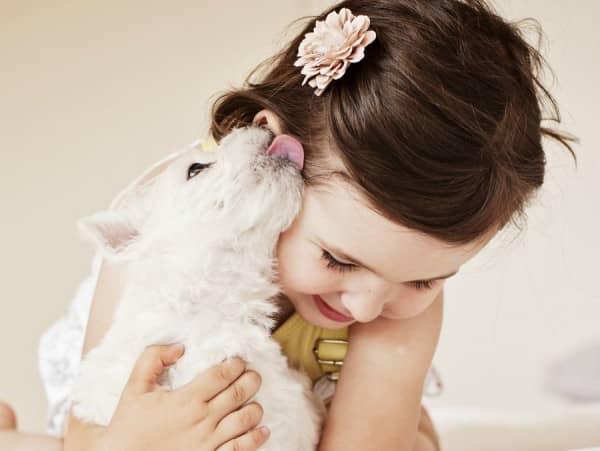When we think of service dogs, using them to help kids with autism isn’t usually the first thing that comes to mind.
I think most of us picture leader dogs for the blind first.
Maybe we remember a story we read about dogs that help detect seizures, diabetic service dogs, or even special pups that help those with hearing difficulties.
I will be the first to admit, I truly had never thought of autism service dogs until recently! I am sharing with you all of the information that I have learned about these special pups and how they help kids with autism in ways you may never have thought possible.
Related ➨ best small dog breed for autistic child
4 Ways Service Dogs Help Kids with Autism
Autism Spectrum Disorder is often diagnosed at an early age, between two and 3 years old.
While not all families and diagnoses qualify for an autism service dog, there are many that do and they often find that having a service dog for their child makes all the difference in the world.
Your doctor can help you find out if you qualify and how to apply.
Below are a few ways in which service dogs can help kids with autism
1- Provide Comfort

When your child is agitated or having sensory overload, as it is sometimes referred to, a service dog can provide your child comfort by simply being there within reach of your child.
Many stories have been told about just touching the dog when a child is having trouble and it will automatically calm them, help them to relax.
Your dog may also lay on your child’s lap, on what is called pressure points and that action will release your child’s anxiety over whatever situation or noise caused the agitation to begin with.
2- Find a Family Member or Handler
https://www.flickr.com/photos/29487672@N07/14504490878/
Service dogs for autism can also be trained to find a certain family member if the handler becomes over-stimulated, or for certain situations that need to be handled. They do so by smell and knowing the actions of the handler when an issue is occurring.
Alternatively, they can also find their handler should they get separated from their parents. Some parents use the dog as an anchor for their child by tethering them to the dog’s lead, especially if the child has a habit of running off.
Not all parents believe in this, so the dog is also trained to follow the child when they take off and lead them back to where they should be.
3- Signaling of Sounds

Since Autism is a sensory disorder, an Autism service dog is trained to signal their handler of specific sounds, such as the smoke alarm or alarm clock.
Because their disorder causes them to process many different things all at once, it sometimes takes them longer to realize the most important one, for example, the smoke alarm going off. The dog signals their handler of the urgent event, allowing their handler to realize that there is something very important happening and to forget everything else.
Service dogs can be trained to lead their person to the item that is causing urgency. In the case of an alarm clock for their handler to wake up, the dog could be trained to respond to the alarm by either touching their handler, removing blankets from the bed, or even flipping a light switch.
4- Stop Repetitive Behaviors

Sometimes kids with autism engage in repetitive behaviors and some can actually be dangerous to that person. This behavior is called “stimming.”
Dogs can alert kids when they are using repetitive behaviors.
They can also alert their handler of the more dangerous repetitive behaviors like hitting themselves, pounding their head against the wall.
While the dog cannot stop the behavior, they can alert their handler of the situation so that they are aware and can consciously make the decision to stop or not. Many times during these behaviors, the service dog can apply pressure to the pressure points to help their handler focus.
While this lists only shows a small fraction of what owning an Autism service dog can be like, there are many other tasks that can be accomplished by properly trained service dogs for autistic children. Keep in mind that owning a service dog is nothing like adopting a pet from a shelter.
While they are companions, they are also working dogs to help you and your family member with Autism and they should be treated as such.



